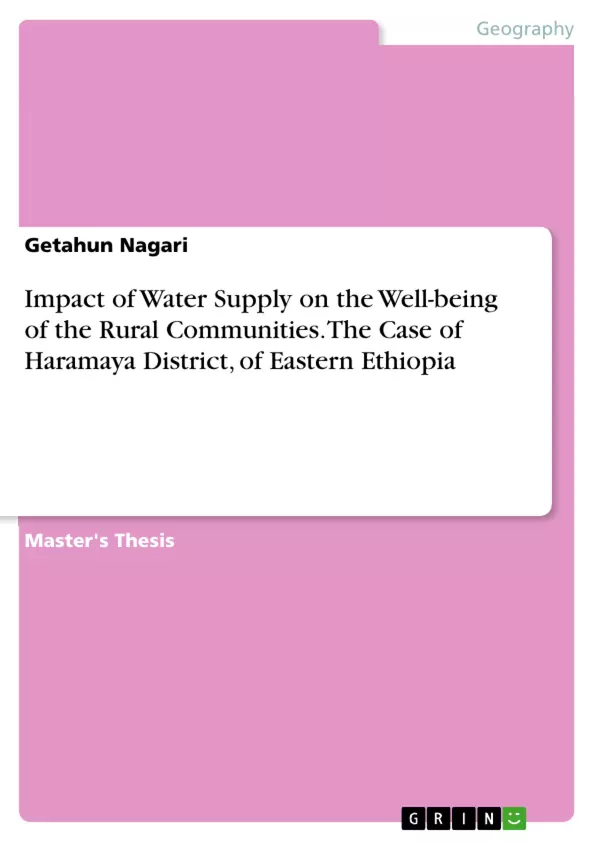This study identifies factors affecting access to potable water supply as well as measures the magnitude of the impact of rural water supply on the wellbeing of the user community using cross-sectional data collected from 200 farm households that were randomly selected from Haramaya District, east Hararghe Zone of Oromia National regional state. Data were analyzed using descriptive, inferential statistics, and propensity score matching (PSM) method. The results obtained from Logit model showed that access to potable water supply are significantly influenced by education, knowledge, quality of water, sustainability and distance of water point from homestead.
Results of the PSM suggest that access to potable water supply significantly decreased households’ expenditure on consumption and medical care by Birr 2497 per annum (55%). Overall, the study provides evidence that policy makers and development practitioners should focus on accessible rural water supply system and investing in alternative watering points such as deep/shallow wells, protected hand dug wells, protected spring on spot and with gravity and easily adoptable low technologies maintained by the community. Moreover, it is important to focus on improving households’ knowledge about PWS, quality of water and basic water point services to improve households’ potable water supply demand.
Inhaltsverzeichnis (Table of Contents)
- CHAPTER ONE: INTRODUCTION
- 1.1 Background of the Study
- 1.2 Statement of the Problem
- 1.3 Objectives of the Study
- 1.3.1 General Objective
- 1.3.2 Specific Objectives
- 1.4 Research Questions
- 1.5 Significance of the Study
- 1.6 Scope of the Study
- 1.7 Organization of the Study
- CHAPTER TWO: LITERATURE REVIEW
- 2.1 Introduction
- 2.2 The Concept of Water Supply and Sanitation
- 2.2.1 Water Supply
- 2.2.2 Sanitation
- 2.3 The Role of Water Supply in Rural Communities
- 2.4 Determinants of Rural Water Supply
- 2.5 Impacts of Rural Water Supply
- 2.5.1 Economic Impacts
- 2.5.2 Health Impacts
- 2.5.3 Environmental Impacts
- 2.5.4 Social Impacts
- 2.6 Constraints in Rural Water Supply Provision
- 2.7 Rural Water Supply and Sustainable Development
- CHAPTER THREE: MATERIALS AND METHODS
- 3.1 Introduction
- 3.2 Study Area
- 3.3 Sampling Techniques and Sample Size
- 3.4 Data Collection Methods
- 3.4.1 Secondary Data
- 3.4.2 Primary Data
- 3.5 Data Analysis Methods
- CHAPTER FOUR: RESULTS AND DISCUSSION
- 4.1 Socio-Economic Characteristics of the Study Area
- 4.1.1 Population
- 4.1.2 Education and Literacy Rate
- 4.1.3 Income Sources
- 4.1.4 Household Size and Composition
- 4.2 Water Supply Systems in the Study Area
- 4.2.1 Water Source Types
- 4.2.2 Water Supply Schemes
- 4.3 Access to Water Supply
- 4.4 Water Consumption Pattern
- 4.5 Water Quality and Treatment
- 4.6 Relationship between Water Supply and Wellbeing
- 4.6.1 Impact of Water Supply on Health
- 4.6.2 Impact of Water Supply on Education
- 4.6.3 Impact of Water Supply on Income
- 4.6.4 Impact of Water Supply on Time Allocation
- 4.7 Constraints to Water Supply Provision
- CHAPTER FIVE: CONCLUSION AND RECOMMENDATION
Zielsetzung und Themenschwerpunkte (Objectives and Key Themes)
The primary goal of this thesis is to investigate the impact of water supply on the well-being of rural communities in the Hararaya District of East Hararghe Zone, Oromia Region, Ethiopia. By examining the specific case study of this rural district, the research aims to provide valuable insights into the multifaceted relationship between water availability and various aspects of community development, including economic, health, social, and environmental considerations. The study will contribute to a better understanding of the challenges and opportunities associated with improving rural water supply systems and their implications for enhancing the well-being of rural communities.
- The significance of water supply in rural communities
- The multifaceted impacts of water supply on rural well-being
- The factors influencing access to and utilization of water supply in rural areas
- Constraints and challenges in providing adequate water supply to rural communities
- The potential for improving rural water supply systems and their impact on sustainable development
Zusammenfassung der Kapitel (Chapter Summaries)
Chapter One provides a comprehensive introduction to the study, outlining the background, problem statement, objectives, research questions, significance, scope, and organization of the research. It sets the stage for understanding the importance of water supply in rural communities and the motivation behind this investigation.
Chapter Two delves into a thorough review of existing literature related to water supply and sanitation in rural areas. This chapter examines the conceptual framework, the role of water supply in rural development, factors influencing its provision, and the multifaceted impacts of water supply on rural communities. It also discusses the constraints faced in delivering adequate water supply and explores the link between rural water supply and sustainable development.
Chapter Three focuses on the materials and methods employed in the research. It provides details about the study area, including its geographical and socio-economic characteristics. The chapter explains the sampling techniques, sample size, data collection methods (both primary and secondary), and the specific data analysis techniques used to investigate the relationship between water supply and well-being.
Chapter Four presents the results of the research and discusses the findings in detail. This chapter analyzes the socio-economic characteristics of the study area, including its population, education, income sources, and household composition. It also investigates the water supply systems in the area, including the types of water sources, water supply schemes, and access to water. Additionally, the chapter examines the water consumption patterns, water quality and treatment methods, and the impact of water supply on various aspects of rural well-being, including health, education, income, and time allocation.
Schlüsselwörter (Keywords)
The primary keywords that define the scope of this research include water supply, rural communities, well-being, development, health, education, income, access, utilization, constraints, challenges, sustainability, Ethiopia, Hararaya District, East Hararghe Zone, Oromia Region, socio-economic factors, and impact.
- Arbeit zitieren
- Getahun Nagari (Autor:in), 2013, Impact of Water Supply on the Well-being of the Rural Communities. The Case of Haramaya District, of Eastern Ethiopia, München, GRIN Verlag, https://www.grin.com/document/1307956



